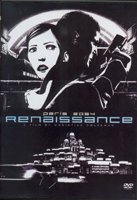
Arch
443/646: Architecture and Film
Fall 2009
Renaissance
2054 (2006)
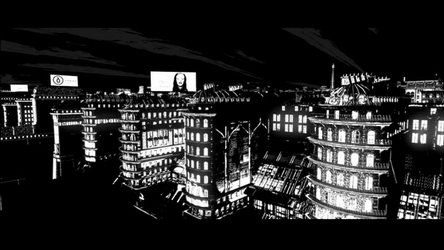
 |
Arch
443/646: Architecture and Film Renaissance
2054 (2006) |
 |
Discussion Questions:
Remember, your images are ABOVE your name.
Please answer the questions below. Use paragraph form. Your answer should be around 400 words. Email me your responses in Word .doc format to: tboake@sympatico.ca I will be posting these each week after the class. You should be prepared to deliver your answer in class -- but paraphrase, do not read it. THINGS TO KEEP IN MIND WHEN ANSWERING THESE QUESTIONS: I am looking for general observations about the film and the relationship to any aspect of MANIPULATING REALITY that we have examined. The images attached to your "words" are to clarify the intention but are not meant to be action specific. PLEASE TIE YOUR ANSWER TO ONE OR MORE OF THE OTHER FILMS THAT WE HAVE VIEWED SO FAR THIS TERM. i.e. how did Renaissance use your word or picture clue to manipulate the film presentation of reality and how did anothe film that we have studied this term do this is a similar way. |
x |
|||||
| 1. | 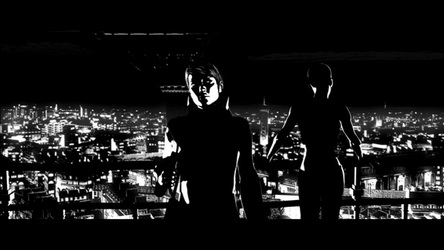 |
||||
Matthew Barbesin In Renaissance, the use of manipulation is that of a neo animated form of film noir, and it is a mainly aesthetic gesture. There are no grey shadings in the film's visual palette to match the characters' more equivocal moralities, and the result is a dark, dark world occasionally exposed to the most harsh and unforgiving of lights. It is shot with such a high contrast, that its almost as if the black’s white negative brings our the details of each shot. |
|||||
| 2. |
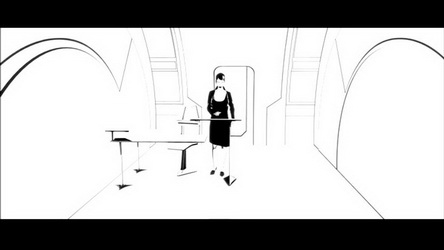 |
||||
Stephanie Boutari As the film Renaissance is primarily black and white all forms of light are represented by white. Therefore differing qualities of light - in colour for example, or if natural or artificial - are undifferentiated. By employing such a high contrast, the film's use of white highlights and emphasizes movements of the figures, which draws all of the viewer's focus on the characters actions. Highlighting these elements heightens the drama in many scenes, for example when facial expressions become completely abstracted and exaggerated with the use of pure white lighting their faces, rather than a more realistic tonal variation. In terms of the film's environmental and architectural settings, the majority of the film is shot at night time, therefore the use of white is partially representative of the city street lights, lit windows and other elements that this light would naturally highlight. However, white is also frequently used to highlight physical elements in a way that light would not, for example in outlining certain buildings, structures or figures. By using white in a manner that does not strictly adhere to the natural behaviour of light, all sense of reality in the film is altered. The viewer is made to feel like he or she is immersed in a new world, as the film is recognizably set in Paris but far in the future. The dominance of night scenes and therefore artificial lighting also appears to emphasize a more technology-dependent, futuristic world. There are two settings in particular where an unnatural abundance of white is used to create a feeling of tension and discomfort in the viewer. This is achieved mainly because of the contexts in which this use of white occurs, as well as its mere artificialness, which give the audience an ominous sense of unfamiliarity combined with a high-tech feel of this 2054 world. The first setting is that of the artificial nature bubble in which the scientist Ilona has been kidnapped. When it first appears, this natural environment is much more brightly lit than the city setting, hence the viewer has the impression that Ilona is in another location, seen during the day. However it is soon apparent that this environment is merely an artificial construction which is constantly brightly lit, serving as a jail in which to trap her and monitor her every move. In the restricted access room in Avalon - the largest and most powerful company in the city - Ilona's sister intrudes to try and retrieve confidential information. In this scene, an unnatural level of light (and use of white) heightens the sense of unfamiliarity and tension. These two situations also serve to reflect the advanced, state-of-the-art and highly secured facilities of avalon, hence their superiority and power in the plot of the film. The film Cube also uses white to convey a sense of unfamiliarity of what is outside the cube, but in a different manner. The external environment of the cube is represented throughout the film as a vast black space, and only when the last survivor manages to escape is it portrayed as pure white. This representation still does not provide any physical clues about the site, however because of this, the white is symbolic of escape and refuge from the deathly confines of the cube. This is much unlike Renaissance where its use correlates with advanced technology, artificiality and sense of foreboding.
|
|||||
| 3. | 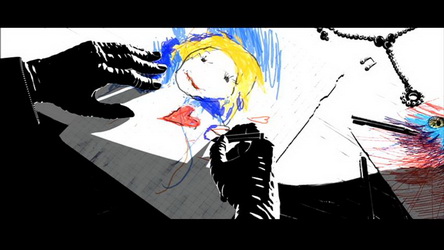 |
||||
Laura Fenwick The film Renaissance features a rare visual style in which almost all images are exclusively black and white. There are hardly any shades of grey in the film. This is why it is interesting that the colour only appears twice in the film when Muller’s brother is drawing. I believe that the film chose to use colour in this scene for two main reasons; to highlight a key point and character in the film, and to represent a crude form of animation in such a high quality animated film. |
|||||
| x | 4. | 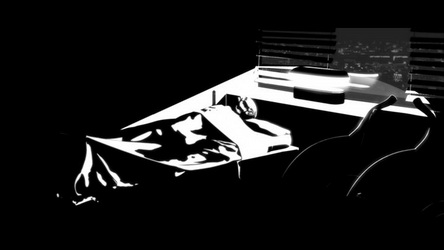 |
x | ||
Nora Guan The film Renaissance is stylized into black and white with ultra sharp contrasts. The successful use of light displays positive and negative spaces while maintaining a sense of depth. The whole story is about the contrast between black and white, good and evil, corruption and justice, love and hate. By removing the gradient of grey, everything becomes so absolute and definable. There is not much character development in the film. For example, Karas spends most of the time to save Ilona throughout the movie; however, she turns evil right after being saved. Karas then kills her without hesitation. Clearly, there is no level of uncertainty and doubt in this film. In order to give the film this sense of highly defined edge, technology and digital manipulation are used to achieve the effect of absolute contrast. |
|||||
| 5. | 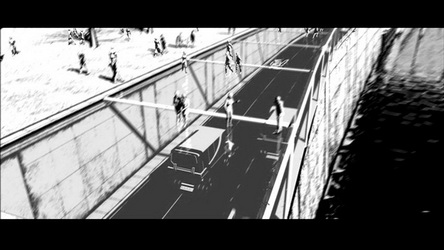 |
||||
Matt Hartney The use of transparency in the film Renaissance takes on several forms in order to manipulate the viewers sense of reality. As this film is set in a tangible future, just over 40 years from now, the Parisian setting of Renaissance is recognizable as a modified version of the Paris of today, with the addition of a considerable amount of vertical density and prominent displays of high technology. Transparency is used in may ways to signify the advancements in technology that set this period apart from the present, and to support the framing of the Avalon Corporation as an all-powerful entity in this future world.
|
|||||
| 6. | 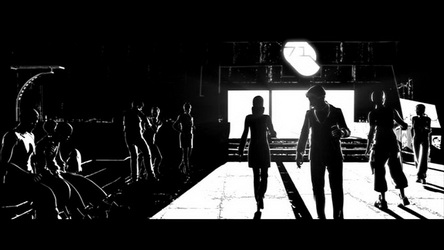 |
||||
Michael Hasey The use of silhouette in the movie Renaissance can be considered one of the driving forces behind its distinctive and dark character. In addition the sense of time is tangled within the force of the silhouette. Objects, people, and architecture are hidden within a blanket of darkness, hiding the defining characteristics of the future that most other sci-fi movies boast.
|
|||||
| 7. | 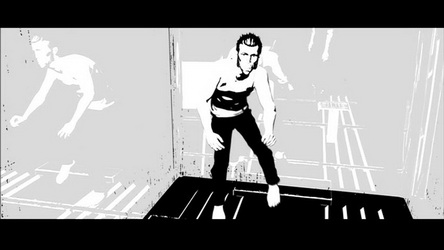 |
||||
Richard Kim In both Solaris and Renaissance, the uses of reflection through mirrors, glass, and water were extensive. These reflections create a heterotopia, where these objects or surfaces start to shape the ways of conceiving the reflected image. In Solaris, the mirrors and the lake are used as a introspective device. Characters, including the realized beings of desire and imagination, enter into a dialogue with the self-consciousness through this device. Forgotten emotions and memories are conjured up and the characters delve deeper into their dream-like moral realm. Bislane lights up a cigarette in her apartment and talks to Karas looking out to the view outside. Through the reflection, personal emotions are heightened and the scene is rendered very intimate. From the reflected view, the viewer is with the person in action, perhaps in the perspective of the centre character, experiencing what is being watched in first person view. Only the surfaces where sufficient light is touched is seen in the reflection at night scenes, and this diminished visibility in turn amplifies the attention by the viewers to the details of body language and facial expressions. In Renaissance, the layering technique is well explored, effects usually hard to capture on film. Overlaying the half reflected face of Karas with that of Dr.Muller, and the conversations in Ilona’s apartment with the backdrop of tour de Eiffel are especially well captured. Without the shades of gray, (except in a couple of scenes), reflectivity on the glass, water, mirrors add great sense of depth and complexity to both form and performance. The multiplication of the one reflected as in the case of Karas entering a glass prison room is an example of mood accentuated using this technique.
|
|||||
8. |
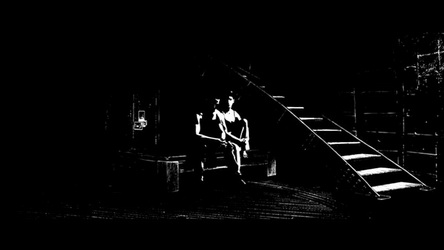 |
||||
Clayton Lent A spotlight is usually used to manipulate a reality through revealing only that which is lit. In doing so an image, or scene is edited. It is usually created using a high intensity beam of light. This is contrasted with the highly directional low-light that is used for much of the scenes in Renaissance. In the world created for the film fire, smoke and illumination become white and create stark contrasts with almost everything else which is in turn black.
|
|||||
| 9. | 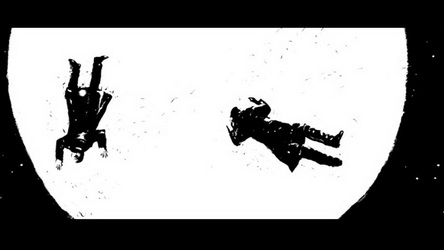 |
||||
Kevin Lisoy High angle in the film Renaissance is very significant to show a different scale of human interaction. Having a camera angle in Big Brother mode alludes to the corrupt mega-corporations and overpowered government swallowing up the human subjects. Often the use of high angle allows the setting - or architecture - to swallow up the subject but in this film I believe the angle relates better to how the characters are being treated.
Similar to the frustration-induced high angles in The Cube, and the zoom-out shots in Solaris, the high camera angles are generally used to scale down the characters to a helpless scale. In Renaissance, however, I believe that this is taken a step further when paired with the animation style of the film. It gives the viewer a very artificial outlook on the future. One thing that further emphasizes the camera angle of the film is the lack of color, which allows the viewer to digest the content through different camera angles.
|
|||||
| 10. | 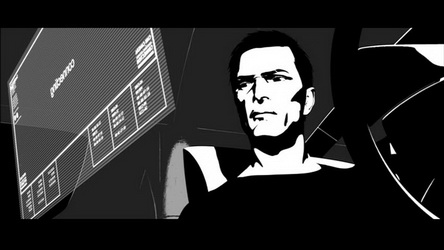 |
||||
Anne Ma The use of the low-angle shot in cinematography is often used as a way of creating the notion of dominance and overpowering. The shot tends to expand the range of view and opens up the view to include not only the subject in focus, most often a character within the film, but also the settings by which the subject is compared to. Relative to a neutral shot in which the camera view is parallel with the subject, the low angle shot is definitely more dynamic and manipulative of the scene at hand. |
|||||
| 11. | 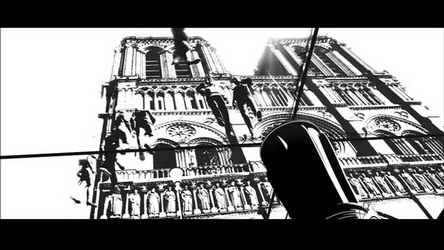 |
||||
Emma Ma The most apparent use of iconography in Renaissance is the use of familiar Parisian architecture in the film. Although the characters did not necessarily interact with these structures, the backdrop immediately sets the location of the film without excessive description. The use of familiar monuments, such as the Thinker, Eiffel Tower, and Notre Dame, anchors the film in its believability as a possible future of the existing site. Viewing recognizable cultural pieces from angles which are not possible in the present or past reinforces the projection of the development of urban fabric. This is exemplified both in Renaissance and Equilibrium when Notre Dame is respectively seen from a worm’s eye view through a glass walkway and in a state of ruin. The billboards and the maze of Thinker statues are iconic in their representation of the multiplicity of capitalist culture, which is prevalent in our current society, but perpetuates more deeply into the future of Renaissance. The first Avalon advertisement is seen rising from the city, above the architectural fabric, and the identical message fills the vision of the inhabitants of Paris 2054 (likewise the political dogma of Equilibrium). This is not unlike the state of our culture today; though with a variety of products, the same bombardment of information in audio and visual presentation are entrenched in our daily lives Due to the focus on technology, the vision of the plot and characters tended to the two-dimensional side. The ideals of the future, such as the surveillance and hard of hard materials (steel and glass, vs. the ambiguity of soft materials, such as clothes) are typical the characters embody stereotypical roles of hero and villain, and the storyline was not developed to a point to invoke any sense of human empathy (typical mystery thriller, a dash of a love story, an unusual suspect for a villain), which makes the movie mildly predictable. However, this may only serve to emphasize the atmosphere of the future-oriented, technologically-focused intention of the film.
|
|||||
| 12. | 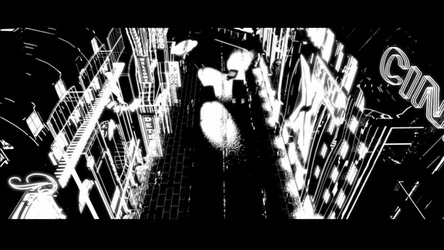 |
||||
Christopher Mosiadz The old city of Paris, as depicted in the Renaissance, is at the ground plane of Christian Volckman’s portrayal of the futuristic vision of the city. Interestingly, the way the city expands in this world is by the vertical layering of buildings over top of the old. This manipulation of reality makes you start to question how the old city can sustain the load of infrastructure and buildings of the new city. This is so far detached from the reality we live in today because, other than skyscrapers, the planners of our cities think in terms of the ground, urban sprawl and the creation of the horizontal city. |
|||||
| 13. | 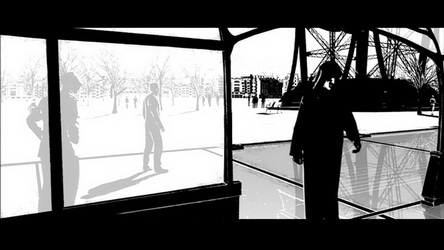 |
||||
Tyler Murray
|
|||||
| 14. | 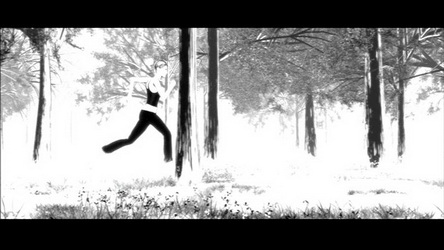 |
||||
Brian Muthaliff Renaissance is situated in the city. For most of the movie, buildings and street are most prevelant. The most intimate interaction with nature occurs when nature is blanketing the city and that is either rain or snow. |
|||||
| 15. | 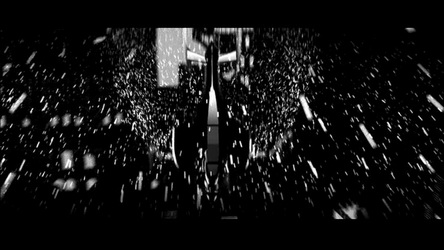 |
||||
Adam Schwartzentruber
|
|||||
| 16. | 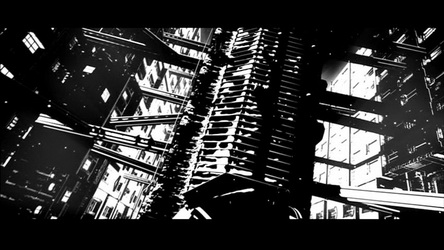 |
||||
Sam Sutherland The materials present in Renaissance are not represented in a manner with which we are generally familiar. We usually see materials represented in film with more-or-less photorealism, but in Renaissance all the materials are rendered in combinations of a small range of black shades, shades of white, and NO shades of grey. As such, the reality which the film presents is highly stylized, as there is no one specific way to represent a material in black and white. Although we do not generally realize it, when we look at the real world with own our eyes, the image received on our retina are not simply projected into our minds in the “dumb” manner that an image is projected on a TV or movie screen. Like the mind of a newborn baby, a TV or even a computer does not actually understand what it is seeing. As we develop, certain portions of the visual cortex learn to recognize specific shapes, patterns, and motions and immediately attribute meaning to them. This happens in such a seamless manner that we take it for granted. Just look at these videos: http://www.youtube.com/watch?v=3mbf1m-gAvE&feature=related Even at our most sane, cool, and calculating, we do not perceive “reality”. We perceive lines, boarders, shapes, expressions, and motions which are brains are pre-programmed to attach meaning to, and from a purely philosophical perspective, there is no way we can really know that there is not a whole other level of significance and meaning in the bare “facts” that enter our eyes. There may be whole other realities before us of which we are unaware because our minds cannot process the physical indications of their existence. The fact that we can interpret stylized cartoon images and materials shows that a large portion of what we see with our own eyes is largely “unnecessary”. Renaissance portrays a reality where all the superfluous visual information is stripped away.
|
|||||
| 17. | 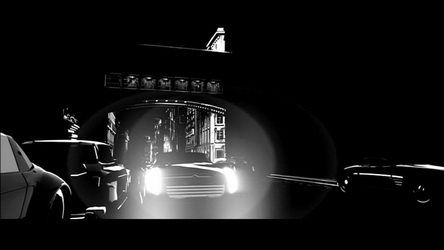 |
||||
Joon Yang Renaissance, depicts transportation that is not much different from contemporary means. However, transportation in renaissance has tendency to be more closely equipped with other infrastructure of city and architecture. It also indicates technological advancement of 2050 Paris featured in this film, which we can easily relate to through transportation infrastructure that exist in current time period. |
|||||
| 18. | 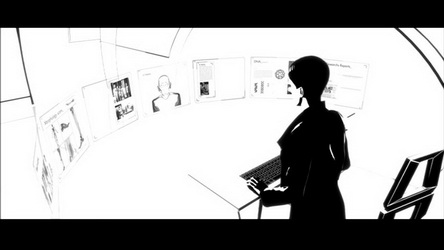 |
||||
Ashley Wood The film Renaissance 2054 uses technology as process for layering the over arching themes of dictatorship and the fountain of youth. Technology begins to build on the dictatorial theme by gradually setting up margins using the symbology of the bill board as the speaker, camera as the eye and the panopticon and the storage device or hard drive for the container of the personal belonging and information of the human race. |
|||||
| 19. | 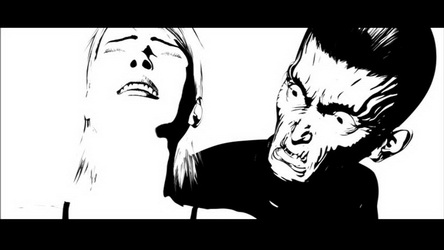 |
||||
Giovanni Comi Face is important for the movie and for the story the movie tells. In my opinion, Renaissance introduce us in a kind of Neo-Expressionist movie. Thanks to use of black and white, without any grey scale colour, it reminds more of Fritz Lang's Metropolis than of Blade Runner. Set in a dark futuristic Paris in 2054, where architecture seems to refer to San'Elia drawings, the movie shows very well a world of shadows and contrasts. Paris is represented as a labyrinthic city where every deed and step is filmed and checked by an all-present organization, Avalon. As we are told at the beginning, Chris Volckman, using black and white, reminds us of a series of oppositions. Bislane, for example, is the mirror and the opposite of her sister, Ilona. The idea is that we can't choose from good or evil, we can just try to avoid the worse. Face plays a key role also in the making of the movie. Looking at the different facial expressions, we don't have the impression to watch a stop motion movie, but a real actor playing a role. Finally, in my opinion, another movie in which the role of face, I mean the shot of face is important, is Stanley Kubrick's The Shining. As a matter of fact in this case, shooting faces, from unusual angles, catches the eye of fear or madness.
|
|||||
| 20. | 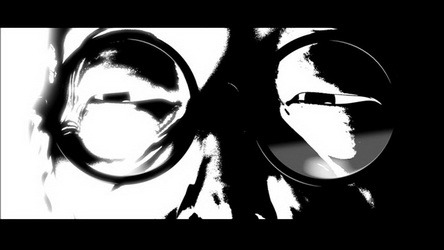 |
||||
Miklos Csonti ‘Renaissance’, being an animated film, is not a movie that manipulates an existing reality in order to convey an alternate one; rather it tries to convey a reality out of nothing at all. However, in order to successfully do so it has to imitate or even recycle elements of reality and adopt a universal language that the audience can relate to and understand. The necessity to impregnate the characters with human-like qualities is therefore an obvious one; and the methods used to communicate these qualities can’t be any different from our own. The eyes are the most expressive, and therefore also the most revealing feature on the human body. They have the ability to communicate age, health, emotion, identity, and even consciousness. It’s not by coincidence that they are often referred to as the windows to the soul. This versatility of the eyes as an indicator of human-like qualities is thoroughly taken advantage of in ‘Renaissance’. The advertisement for the age-defying clinic of Avalon uses the transformation of the eye from old to young in order to sell their product. When Ilona’s sister Bislane breaks into Avalon, the company’s security system uses an eye-scan as a method of identification. Also, on more than one occasion the dialogue between characters is animated and dramatized by close-ups of the eyes as they react with emotional expression. Naturally in order to keep these sequences as realistic as possible, the animators even mimicked the eye-movements of the real-life actors used in the motion-capture recordings. The final result is one that allows the audience to connect and maybe even sympathize with beings whose DNA is essentially made up of binary code. While the eyes of the characters emphasise the presence of human-like qualities in ‘Renaissance’, the eyes of Jack Torrance in ‘The Shining’ act as a gauge to indicate the status of his sanity. Jack gradually goes through a state of transformation from a well-intentioned father/husband to a murderous disciple of the hotel. As this transformation is not a linear one, the audience is often left wondering what his current state of mind really is. Well Jack Nicholson’s eyes certainly have a way of hinting whether we can remain calm or whether we should be scared, but most importantly they have the ability to make us feel uneasy and alert as they linger in a menacing grey-area.
|
|||||
| 21. | 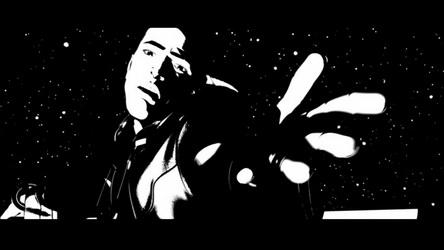 |
||||
Joel DiGiacomo Renaissance is a thoroughly formulaic film with one tremendously redeeming feature: its stylized animation format. The visuals are extremely innovative and engaging, while everything else —the plot, the characters, the camera angles, the music— takes a more conventional approach. The emotion of the characters is, as stated by the filmmakers in The Making Of video, central to all action in the film. Each of the characters’ mood, circumstances, and interactions has a corresponding emotional response that is presented in typical fashion. For example, if the emotion is more intense, the shot is closer, or in some cases, simply involves more camera movement. With the exception Ilana’s first encounter with the simulated forest, every emotion is matched with the expected musical score. Because the plot is relatively complex, and the visuals often distracting, the directors seem to have employed every other cinematic element as straight–forwardly as possible in order to spell out the action as clearly as possible.
|
|||||
| 22. | 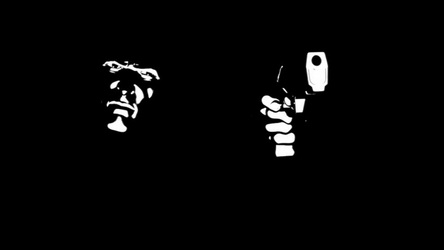 |
||||
Ryan Yeung Renaissance is a recent film, and as a recent modern day film, it tends to depict action sequences in an overtly grand portrayal with emphasis on tension and spectacle. In this way we can see it as a close resemblance with Equilibrium in that the action sequences which almost always involves the use of guns, are quick and flashy. They demonstrate the brutality of violence with loud noises and swift but strong impact. Typical of an action film, blood is not emphasis despite the abundance of violence throughout the story. This is to take away from the idea of death (that is taken care of by drama) and instead to implement the devices of struggle and tension to further the storyline. The chase sequence when Karas pursues Ilona’s stolen vehicle acts as a struggle in which violent behaviour manifests. Violence becomes a means of unfolding reality and uncovering the truth. Violence is also the catalyst in which the story begins, the reality that is then manipulated. Ilona is forcefully kidnapped through the first act of violence. From there, the controversial and aggressive nature of Karas begins to search for truth through the use of violence. Establishing his character right away with the hostage scene where he successfully eliminates the hostages, his character begins to unfold with the chase scene, interrogation scene, reckless entrance into the arboretum, and countless other acts of brutality. It is this device that allows the truth to be exposed and the story to be told. It is interesting as well, to see that throughout the film we are given the impression that Ilona is the one that needs to be rescued. We are assured under the film’s premise that Ilona will undoubtedly be saved and a happy ending will unfold. But we soon find this as a mask for the true realities of the story, in the Muller, the kidnapper, is actually trying to save the world. Though this is morally ambiguous, this revelation of the cure for mortality turns our views upside down and questions whether Karas should really be saving her. And, in the final act of violence, which is contrasted in the brute force of the other action sequences, Ilona is portrayed villainously when the true reality of revealed, and murdered by Karas in a clean and slick fashion as her body smoothly slinks onto the ground with grace.
|
|||||
| 23. | 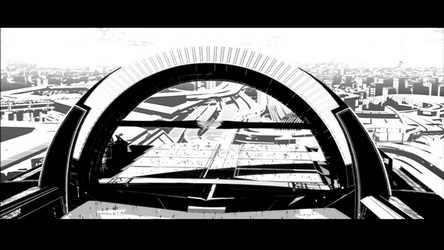 |
||||
Alejandro Fernandez
|
|||||
THE QUESTIONS BELOW DEAL DIRECTLY WITH THE MAKING OF THE FILM AND THE EFFECTS THAT THESE ISSUES HAVE ON THE FEELINGS OR REPRESENTATION OF MADNESS IN THE FILM. |
|||||
| 24. | 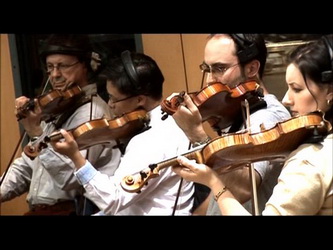 |
||||
Tanya Fuize When talking about Paris, usually the first thing that comes to mind is the city of romance, beauty and art. In Renaissance, what is seen as the future of Paris is a cold, creepy and dark city full of crime. This movie is subjected to manipulate our familiar perception of the city and of the future. The role that the music plays is relatively dominant in presenting and transferring this sense of manipulation. |
|||||
| 25. | 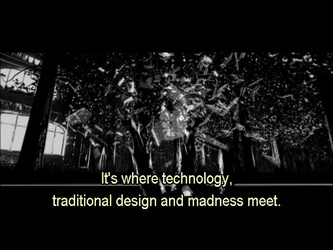 |
||||
Holland Young During the Making of Renaissance featurette (originally a French television special about the film) the motion picture’s visual style is described as “where technology, traditional design and madness meet”. In what was a very untraditional inception, Renaissance was originally conceived as a medium for the exploration of innovative black and white animation, motion capture technology, and the team’s picture of a futuristic Paris. In this case, the story was secondary: required only as a traditional base for, and means to convey, these technological aspirations and vision of the future. For this reason, the narrative follows a classic and involved film noir structure, complete with femme fatales, lonesome detectives, seedy crime bosses and evil villains. This familiar genre, along with the archetypal characters, provides an effective (if unoriginal) foundation for audiences to use to explore the film’s visual fantasies, which may have proven too surreal for the average movie viewer without the incorporation of these recognizable narrative elements.
The main contrast between the vision behind Renaissance and that behind most theatrical productions, along with most other movies we have watched this term, is that, rather than starting with a visual goal and building a narrative in order to achieve that goal, traditional live theatre starts with a story and then find the best technology and/or imagery to portray said story. Another difference is the variation in scale of the settings involved in the film verses those which are involved in live theatre. The power behind the director’s vision of a futuristic Paris is often established with striking, sweeping shots of the city from a distance, which would not be possible to translate into a stage environment where scale is often limited by a constructed set’s relationship to the human players. One last major difference between the vision for Renaissance versus that for typical live theatre that I want to highlight is use of colour. While Renaissance is able to use extreme angles, other virtual camera tricks, and a formulaic film noire storyline to convey atmosphere, live theatre often uses colour to evoke the same types of responses from the audience. Although set paint and good stage makeup could turn a theatrical production black and white, much would be lost without the ability to use colour in order to translate the smoky lounge feeling of the nightclub or the surreality of Ilona’s virtual prison.
|
|||||
| 26. | 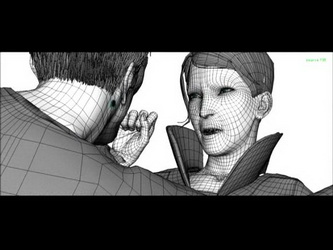 |
||||
John Lee While Renaissance is the only film we’ve studied in the course that uses the motion capture technique, there are similarities in the way Renaissance uses the technique to manipulate reality and in the manipulated realities of the first “city films” we watched this term, Berlin and Man With A Movie Camera. When considering the discussion topic, I made an instinctual comparison with Solaris, drawing similarities between the apparitions created by Solaris, like Hari, and the frequent use of holograms in Renaissance. Rather than “motion capture”, however, the holograms and Hari are “captured motion”; they are alternate realities within a primary reality, but don’t directly relate to the way in which motion capture manipulates reality. Motion capture is the technique in which actors wear special suits with reflective sensors that allow computers to track their movements and plot them in a Cartesian system. The animators of Renaissance used this data as a base for their CG characters, achieving a level of realism that would be difficult with animation alone. This concept of robotizing people is also apparent in Berlin and Man With A Movie Camera. In both films, the citizenry of Berlin and Moscow, respectively, are secondary to the machines and even the architecture of the cities. Both directors, while attempting to glorify the modernity and technical prowess of their cities, dehumanize the real people captured in their films. Early on in Man WIth A Movie Camera, for example, a mannequin is seated at a sewing machine, implying the evolution of the machine beyond a human master. This is contrasted later by a woman sewing, rather painstakingly, by hand. Vertov demonstrates that his vision of Moscow has moved beyond a “human” time frame: in the blink of an eye, a couple can get married, then divorced, and life can quickly turn to death—all while the machine that is the city continues on. Berlin emphasizes this uneasy relationship between man and machine in a scene in which jaywalkers struggle to cross a busy street, faced with oncoming trams and automobiles. Berlin and Moscow project the mechanized ideal of the early 20th century, in which the standardization and dehumanization of their populations are acceptable in the name of progress.
|
|||||
| 27. | 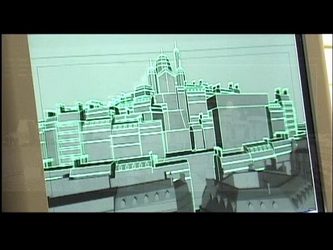 |
||||
Raja Moussaoui The film ‘Renaissance 2054’ is set in an imagined Paris of the near future. In rendering this manipulation of reality to project this futuristic look, the makers of the film drew animations of an imagined city. This imagined city was not drastically different from present day Paris; futuristic looking buildings were presented in well known Parisian vistas, but the city was nevertheless still distinctive and recognizable. Animation was used to elegantly render these changes, which would have been far more difficult and less convincing if done to look realistic. What is significant is that the notion of a futuristic Paris is easy to accept because of the style of animation used in the film. Since the film was made in high contrast black and white, without the use of shadow, even the scenes of ordinary streetscapes and interior spaces were stylized. The transition from these stylized compositions, set in realistic situations, to the view of the semi-futuristic city is a smooth one, and it is not difficult for viewer to accept the film as fiction without being offended or overly distracted by the changes to the familiar Parisian imagery. Similarly, the film ‘Berlin: Symphony of a Great City’ presents Berlin in a new way by animating the scenes order to present a new reality of citylife. Although this film is not an animated film like ‘Renaissance’ the close shots of the machine parts moving, and the rhythm of these movements in sync to the music playing, abstract the view of the city enough to make ordinary looking objects seem part of a bigger, living, breathing being. This abstraction provides an interesting way to animate the place of a city, and manipulate reality. However it may have seemed less comprehensible had it not been for the careful sequencing of scenes leading to the more animated/abstracted portions of the film. The sequence of filming the moving train coming into the city, followed by the shots of the streets in the morning, gradually builds towards the more unusual scenes of the machinery’s relentless movement which really allow us to understand the city as a living entitiy. Like in Renaissance, this animation of place works because of its appropriate transition from slight abstracted to noticeably significant manipulation of reality. These films both present a vision of the future. ‘Renaissance 2054’ literally uses drawn animation to project a city of the future, while ‘Berlin, Symphony of a Great City’ uses camera angles, repetitive movements, and rhythms to animate places through abstractions, in order to present a vision for a city of the future. Both are successful in their manipulations of reality because the respective filmmakers managed to sensitively create animations which were convincing, if only for the duration of the film. |
|||||
updated 27-Dec-2009 1:14 PM